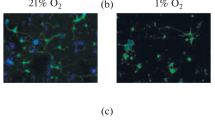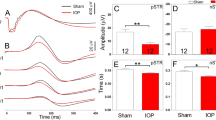Abstract
Background
Glaucoma is a term encompassing a variety of diseases that end in the death of retinal ganglion cells (RGC). Although a variety of factors can initiate the disease onset, increased intraocular pressure (IOP) is one of the major risk factors. In our previous study we found that semaphorins were causally involved in RGC death following axotomy. Since a common feature of all retinal neuropathies is axonal damage, we hypothesized that semaphorins are involved in glaucoma-induced RGC death. The purpose of this study was to analyze the effect of increased IOP on RGC viability and to analyze semaphorin expression pattern in glaucomatous retinas.
Methods
Utilizing retrograde-labeled dye (4-Di-10-Asp) and hematoxylin-eosin staining, we investigated the effect of elevated levels of IOP on RGC viability. In addition, immunohistochemical analysis and western blotting were used to study the pattern of semaphorin expression in retinas of rabbits with genetically developed increased IOP and subsequently glaucoma.
Results
Using specific anti-semaphorin antibodies, the expression of a single protein with the size of a semaphorin protein, 110 kDa, was detected; its expression was up-regulated in glaucomatous rabbits compared with controls. Time-course analysis revealed that semaphorin expression peaked between 2 and 6 months of age and declined thereafter. Immunohistochemical analysis revealed that semaphorin expression was up-regulated specifically in the ganglion cell layer, which is a structure that is highly affected in glaucoma.
Conclusion
Deciphering the molecular mechanisms of glaucoma-induced death and its mediators is a crucial step towards designing new therapeutic strategies to treat this incurable disease.





Similar content being viewed by others
References
Anderson DR (1989) Glaucoma: the damage caused by pressure. XLVI Edward Jackson memorial lecture. Am J Ophthalmol 108:485–495
Anderson DR, Hendrickson A (1974) Effect of intraocular pressure on rapid axoplasmic transport in monkey optic nerve. Invest Ophthalmol 13:771–783
Armaly MF, Krueger DE, Maunder L, Becker B, Hetherington J Jr, Kolker AE, Levene RZ, Maumenee AE, Pollack IP, Shaffer RN (1980) Biostatistical analysis of the collaborative glaucoma study. I. Summary report of the risk factors for glaucomatous visual-field defects. Arch Ophthalmol 98:2163–2171
Cohen-Michaeli A, Jacot JL, Rosner M, Solomon AS (1996) Corneal findings in rabbits with inherited glaucoma. Invest Ophthalmol Vis Sci 37(Suppl):189
David R, Livingston DG, Luntz MH (1977) Ocular hypertension—a long-term follow-up of treated and untreated patients. Br J Ophthalmol 61:668–674
De Winter F, Oudega M, Lankhorst AJ, Hamers FP, Blits B, Ruitenberg MJ, Pasterkamp RJ, Gispen WH, Verhaagen J (2002) Injury-induced class 3 semaphorin expression in the rat spinal cord. Exp Neurol 175:61–75
Gaasterland D, Tanishima T, Kuwabara T (1978) Axoplasmic flow during chronic experimental glaucoma. 1. Light and electron microscopic studies of the monkey optic nerve head during development of glaucomatous cupping. Invest Ophthalmol Vis Sci 17:838–846
Geyer O, Wollman Y, Chernihovsky T, Laina A, Lazar M, Solomon AS (1999) Elevated nitric oxide (NO) levels in buphthalmic rabbits. invest. Opthalmol. Vis. Sci. 37:834
Glovinsky Y, Quigley HA, Dunkelberger GR (1991) Retinal ganglion cell loss is size dependent in experimental glaucoma. Invest Ophthalmol Vis Sci 32:484–491
Goodman CS (1994) The likeness of being: phylogenetically conserved molecular mechanisms of growth cone guidance. Cell 78:353–356
Goodman CS (1996) Mechanisms and molecules that control growth cone guidance. Annu Rev Neurosci 19:341–377
Goshima Y, Nakamura F, Strittmatter P, Strittmatter SM (1995) Collapsin-induced growth cone collapse mediated by an intracellular protein related to UNC-33. Nature 376:509–514
Griffin JW, Watson DF (1988) Axonal transport in neurological disease. Ann Neurol 23:3–13
Gu Y, Ihara Y (2000) Evidence that collapsin response mediator protein-2 is involved in the dynamics of microtubules. J Biol Chem 275:17917–17920
Gu Y, Hamajima N, Ihara Y (2000) Neurofibrillary tangle-associated collapsin response mediator protein-2 (CRMP-2) is highly phosphorylated on Thr-509, Ser-518, and Ser-522. Biochemistry 39:4267–4275
Hanna BL, Sawin PB, Sheppard LB (1962) Recessive buphthalmos in rabbits. Genetics 47:219–521
Harlow EL (1988) A laboratory manual. Cold Spring Harbor Laboratory Press
Hirsch E, Hu LJ, Prigent A, Constantin B, Agid Y, Drabkin H, Roche J (1999) Distribution of semaphorin IV in adult human brain. Brain Res 823:67–79
Kolodkin AL (1996) Growth cones and the cues that repel them. Trends Neurosci 19:507–513
Lazarov-Spiegler O, Solomon AS, Schwartz M (1999) Link between optic nerve regrowth failure and macrophage stimulation in mammals. Vision Res 39:169–175
Lubec G, Nonaka M, Krapfenbauer K, Gratzer M, Cairns N, Fountoulakis M (1999) Expression of the dihydropyrimidinase related protein 2 (DRP-2) in Down syndrome and Alzheimer's disease brain is downregulated at the mRNA and dysregulated at the protein level. J Neural Transm Suppl 57:161–177
Luo Y, Raible D, Raper JA (1993) Collapsin: a protein in brain that induces the collapse and paralysis of neuronal growth cones. Cell 75:217–227
Luo Y, Shepherd I, Li J, Renzi MJ, Chang S, Raper JA (1995) A family of molecules related to collapsin in the embryonic chick nervous system. Neuron 14:1131–1140
Messersmith EK, Leonardo ED, Shatz CJ, Tessier-Lavigne M, Goodman CS, Kolodkin AL (1995) Semaphorin III can function as a selective chemorepellent to pattern sensory projections in the spinal cord. Neuron 14:949–959
Morrison JC, Nylander KB, Lauer AK, Cepurna WO, Johnson E (1998) Glaucoma drops control intraocular pressure and protect optic nerves in a rat model of glaucoma. Invest Ophthalmol Vis Sci 39:526–531
Nakazawa T, Tomita H, Yamaguchi K, Sato Y, Shimura M, Kuwahara S, Tamai M (2002) Neuroprotective effect of nipradilol on axotomized rat retinal ganglion cells. Curr Eye Res 24:114–122
Pasterkamp RJ, Anderson PN, Verhaagen J (2001) Peripheral nerve injury fails to induce growth of lesioned ascending dorsal column axons into spinal cord scar tissue expressing the axon repellent Semaphorin3A. Eur J Neurosci 13:457–471
Pease ME, McKinnon SJ, Quigley HA, Kerrigan-Baumrind LA, Zack DJ (2000) Obstructed axonal transport of BDNF and its receptor TrkB in experimental glaucoma. Invest Ophthalmol Vis Sci 41:764–774
Percicot CL, Schnell CR, Debon C, Hariton C (1996) Continuous intraocular pressure measurement by telemetry in alpha-chymotrypsin-induced glaucoma model in the rabbit: effects of timolol, dorzolamide, and epinephrine. J Pharmacol Toxicol Methods 36:223–228
Quigley HA (1999) Neuronal death in glaucoma. Prog Ret Eye Res 18:39–57
Quigley HA, Hohman RM (1983) Laser energy levels for trabecular meshwork damage in the primate eye. Invest Ophthalmol Vis Sci 24:1305–1307
Quigley HA, Davis EB, Anderson DR (1977) Descending optic nerve degeneration in primates. Invest Ophthalmol Vis Sci 16:841–849
Quigley HA, Nickells RW, Kerrigan LA, Pease ME, Thibault DJ, Zack DJ (1995) Retinal ganglion cell death in experimental glaucoma and after axotomy occurs by apoptosis. Invest Ophthalmol Vis Sci 36:774–786
Shirvan A, Ziv I, Fleminger G, Shina R, He Z, Brudo I, Melamed E, Barzilai A (1999) Semaphorins as mediators of neuronal apoptosis. J Neurochem 73:961–971
Shirvan A, Kimron M, Holdengreber V, Ziv I, Ben-Shaul Y, Melamed S, Melamed E, Barzilai A, Solomon AS (2002) Anti-semaphorin 3A antibodies rescue retinal ganglion cells from cell death following optic nerve axotomy. J Biol Chem 277:49799–49807
Solomon AS (1995) Congenital glaucoma in rabbits. Invest Ophthalmol Vis Sci 36:986u
Sommer A (1989) Intraocular pressure and glaucoma. Am J Ophthalmol 107:186–188
Tessier-Lavigne M, Goodman CS (1996) The molecular biology of axon guidance. Science 274:1123–1133
Ueda J, Sawaguchi S, Hanyu T, Yaoeda K, Fukuchi T, Abe H, Ozawa H (1998) Experimental glaucoma model in the rat induced by laser trabecular photocoagulation after an intracameral injection of India ink. Jpn J Ophthalmol 42:337–344
Ueno A, Tawara A, Kubota T, Ohnishi Y, Inomata H, Solomon AS (1999) Histopathological changes in iridocorneal angle of inherited glaucoma in rabbits. Graefes Arch Clin Exp Ophthalmol 237:654–660
Yoshida H, Watanabe A, Ihara Y (1998) Collapsin response mediator protein-2 is associated with neurofibrillary tangles in Alzheimer's disease. J Biol Chem 273:9761–9768
Acknowledgements
This work was supported in part by grants from the Israeli Ministry of Health (to A.B.) and the Stein Research Fund (to A.S.S.).
Author information
Authors and Affiliations
Corresponding author
Rights and permissions
About this article
Cite this article
Solomon, A.S., Kimron, M., Holdengreber, V. et al. Up-regulation of semaphorin expression in retina of glaucomatous rabbits. Graefe's Arch Clin Exp Ophthalmol 241, 673–681 (2003). https://doi.org/10.1007/s00417-003-0684-y
Received:
Revised:
Accepted:
Published:
Issue Date:
DOI: https://doi.org/10.1007/s00417-003-0684-y




